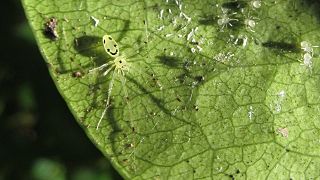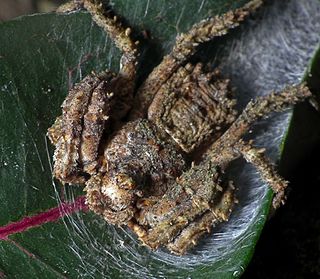
The Thomisidae are a family of spiders, including about 175 genera and over 2,100 species. The common name crab spider is often linked to species in this family, but is also applied loosely to many other families of spiders. Many members of this family are also known as flower spiders or flower crab spiders.

Huntsman spiders, members of the family Sparassidae, are known by this name because of their speed and mode of hunting. They are also called giant crab spiders because of their size and appearance. Larger species sometimes are referred to as wood spiders, because of their preference for woody places. In southern Africa the genus Palystes are known as rain spiders or lizard-eating spiders. Commonly they are confused with baboon spiders from the Mygalomorphae infraorder, which are not closely related.

Parasteatoda tepidariorum, the common house spider, referred to internationally as the American house spider, is a spider species of the genus Parasteatoda that is mainly indigenous to the New World, with P. tepidariorum australis but has achieved a cosmopolitan distribution. American house spiders are synanthropic and build their tangled webs in or near human dwellings, greenhouses or similar, often in secluded areas such as between loose walls and behind open doors and attic windows. Statistically, they are the most often encountered spider by humans in North America, and least likely to adopt defensive behavior in their vicinity. Their prey mechanism is similar to that of the other cobweb spiders: the spider follows disturbances transmitted along the web to entangle and then paralyze its prey, which usually consists of household insects and other invertebrates.

Austracantha is a genus of spider with a single species, Austracantha minax, commonly known as the jewel spider or the Christmas spider. It is a member of the family Araneidae and is endemic to Australia. They are relatively small spiders, reaching a maximum total body length of only around 12 mm (0.47 in) for females, and 5 mm (0.20 in) for males. Their abdomen has six distinctive projections ("spines") that makes them easy to identify. They are predominantly a shiny black, with variable white, yellow, and orange patterns. Melanistic forms also occur during autumn. They are facultatively gregarious, and can be found in large aggregations of overlapping orb webs. They feed on small flying insects that get entangled in their webs. They are harmless to humans, though the webs can be a nuisance for bushwalkers. They are most abundant during the summer months.

The black house spider or common black spider is a common species of cribellate Australian spider, introduced to New Zealand and Japan. A closely related species, Badumna longinqua, the grey house spider, has a similar distribution, but has also been introduced to the Americas.

Theridion grallator, also known as the Hawaiian happy-face spider, is a spider in the family Theridiidae that resides on the Hawaiian Islands. T. grallator obtains its vernacular name of "Hawaiian happy-face spider" from the unique patterns superimposed on its abdomen, specifically those that resemble a human smiling face. Its Hawaiian name is nananana makakiʻi. The specific epithet grallator is Latin for "stilt walker", a reference to the species' long, spindly legs. T. grallator is particularly notable because of its wide range of polymorphisms that may be studied to allow a better understanding of evolutionary mechanisms. In addition to the variety of color polymorphisms present in T. grallator, this spider also demonstrates the interesting quality of diet-induced color change, in which its appearance temporarily changes as it metabolizes various food items.

Araniella cucurbitina, sometimes called the "cucumber green spider", is a spider of the family Araneidae.

Deinopis subrufa is a species of net-casting spiders. It occurs in Australia and in New Zealand. It is a nocturnal hunter, having excellent eyesight, and hunts using a silken net to capture its prey. They feed on a variety of insects – ants, beetles, crickets and other spiders. They can vary in color from fawn to pinkish brown or chocolate brown. Females are about 25 mm in body length, males about 22 mm. They are not dangerous to humans.

Phonognatha graeffei, referred to as the leaf curling spider, is a common Australian spider found in woodlands and urban areas in the northeastern, eastern and southern states. A small member of the family Araneidae, the orb-weavers, it was previously placed in Tetragnathidae.

Plebs bradleyi, synonym Araneus bradleyi, is a spider in the orb-weaver family Araneidae. Known as the enamelled spider, it is a common Australian spider. It occurs in Tasmania, New South Wales, Queensland and Victoria.

Arachnura higginsi, known as the tailed spider or scorpion tailed spider and the scorpion orb weaver, is a common Australian spider belonging to the family Araneidae. It occurs in many parts of Australia.

Arkys lancearius, the triangular spider, is a common Australian spider belonging to the family Arkyidae. It is an ambush hunter, commonly found resting on leaves and ferns or hanging from just a few threads of silk. The front two pairs of legs are large, suited for grabbing small insects, while the rear pairs of legs are much smaller.

Ariamnes colubrinus, known as the whip spider, is a common Australian spider belonging to the family Theridiidae. It is found in Victoria, New South Wales and Queensland.

Sidymella is a genus of spider in the family Thomisidae, found in South America, Australia and New Zealand. It was originally named Sidyma, but this was later found to have been used already for a genus of moths.

Tetragnatha montana, commonly known as the silver stretch spider, is a species of long-jawed orb weaver from the family Tetragnathidae that has a Palearctic distribution. It preys mostly on flies and mosquitoes. The name silver stretch spider refers to its shiny metallic colour and its habit of extending its legs into a stick like shape.

Stephanopis altifrons is a crab spider found in Australia. A cryptic species often hidden on bark of a tree. The body length of the female is up to 10 mm, the male 6 mm. The colour is usually brown, or shades of grey, sometimes black. The egg sac is 7.5 mm in diameter. Often placed in a crevice in tree bark; irregular in shape and camouflaged with debris. Eggs are off white in colour, 25 to 30 in number. The female rests with the eggs. The food of this spider is appears to be other spiders. Recorded prey include spiders in the families Salticidae and Hersiliidae.

Cyrtophora hirta is a species of tent spider found in the Australia. The southern range of distribution is near Sydney, though there are New Guinea and Tasmanian records on the Atlas of Living Australia. Ludwig Koch described the species in 1872 from specimens from Bowen, Queensland.

Australomisidia cruentata, one of the crab spiders, is a small spider found in Australia. The body length of the female is up to 5 mm, the male 3 mm. An ambush predator, often seen on flowers in the Pultenaea group of egg and bacon plants, belonging to the pea family. The egg sac is also laid on the flowers. Petals being fastened with silk in a chamber. The spider stays with the eggs, probably still hunting from the entrance of the retreat, with the egg sac nearby. Prey is small flying insects. The genus Australomisidia was created in 2014, the word being a combination of Australia and Thomisidae, the crab spiders.

Venatrix furcillata, one of the wolf spiders, is a mid sized spider found in eastern Australia. The body length of the female is up to 13 mm, the male 9 mm. The abdomen has distinctive tapering markings. Sometimes noted in suburban gardens and lawns. It lives in a simple burrow, but may be seen migrating in large numbers to a communal web, an unusual feature for wolf spiders. The grey coloured spherical egg sac is around 6 mm in diameter, carried by the female. Eggs are 45 to 60 in number, 0.8 mm in diameter. Prey is ground dwelling insects. The spider has been identified as occurring in Queensland, New South Wales, and Victoria.

Arbanitis robertsi is a species of tube spider in the family Idiopidae found in and near rainforests in New South Wales and Queensland, Australia. A mid to large sized spider which builds a tube of web that extends from the burrow. The tube is attached to rocks, tree ferns or the base of trees. Thousands of these tubes were recorded by Sid Jackson in November 1922 at the south eastern end of Wallis Lake. "Up to three feet long, and half an inch wide". Situated on damp ground, close to freshwater streams.




















